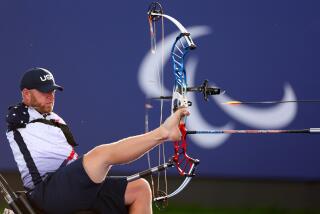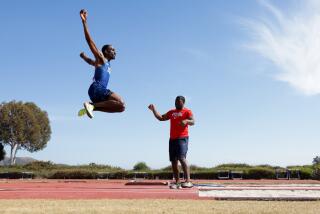Steady as They Go : Amputee Golfers Give Stirring Lesson in Course Management
- Share via
Having a bit of a problem on the golf course these days, are you? Can’t quite seem to find the correct position for your feet? Not shifting your legs properly? Wondering if your hands have formed the perfect grip on the club?
Want to feel a whole lot better about your problems in a hurry? Stop by the River Ridge Golf Course in Oxnard today or Sunday and watch a bunch of golfers hitting the ball straight off the tee and true to the green. And notice that some of them have just one arm. Or no arms. Or just one foot. Or just one leg. Or no feet and no legs.
“This is amazing. Just amazing,” said Ray Milewsky of Camarillo, who served as a ball spotter at River Ridge during this week’s 20th Western Amputee Golf tournament. “I shoot in the 80s and most of these guys would tear me apart on the golf course. It makes you feel pretty silly for complaining about the way we play golf.”
The Western Amputee Golf Assn., a branch of the National Amputee Golf Assn., has 300 members, according to tournament director Jim Polson of Reseda. Sixty are gathered in Oxnard for the 54-hole tournament. Their goal, as the association’s constitution states, is “to rehabilitate amputees. To provide for their general welfare, both physical and psychological, through golf and associated activities.”
But mostly what they did was leave in their wake a group of gaping onlookers, golfers such as Milewsky who have all of their limbs intact and could not quite believe what they were seeing.
What they were seeing was one-legged Lloyd Watkins balancing himself on his left leg and pounding a golf ball 220 yards down the fairway and then screaming a 5-iron to the middle of the green.
They were seeing one-armed Jim Regnolds holding the club with the aid of a metal clamp attached to his artificial right arm and launching every tee shot as straight as a laser and sinking every putt inside 10 feet.
They were seeing legless Dick Bell plopping down onto an aluminum frame with a sheepskin cover on the seat and reaching every par-4 hole in regulation, with long and accurate drives and solid iron play. While sitting .
They were seeing armless Jim Taylor tee the ball up with his feet, grip the club with artificial limbs that reach all the way to his shoulders and swing with alarming power, rocketing his drives more than 200 yards.
And they were seeing William Rich, a one-armed golfer who uses no prosthesis, holding the club with only his right hand. Rich is a three-time winner of the tournament. Three times he has, on a regulation course of more than 6,500 yards, shot a round of 6-under-par 66.
This is what a few spectators and some tournament sponsors were seeing. But still, they weren’t quite believing.
“If you play golf and know just how hard the game of golf is, you can’t quite imagine how these guys do it,” Jon Erskine of Moorpark said. “You watch and you’re sure these guys are going to fall down when they swing. And when they don’t and the ball goes right where it’s supposed to go every time, well, I can’t get over it.”
All of the amputee golfers have fallen. They’ve fallen hard. But they’ve all picked themselves back up.
Watkins lives in Mesa, Ariz. A paratrooper in the Army’s 82nd Airborne Division, he lost his right leg on Oct. 2, 1944, when a German artillery shell launched from 18 miles away slammed into Watkins’ base camp in Holland. He had never played golf, but 16 years after losing his leg he decided to give it a try. And two years later, balancing himself on his one leg, he shot an astounding round of 62 on his home course in upstate New York.
On the first tee at River Ridge, his playing partners for the day stood behind Watkins as he teed up a ball. With his left calf muscles bulging and the scars from the mid-thigh amputation of his right leg showing beneath his Bermuda shorts, he steadied himself and quickly unleashed a picture-perfect swing. The ball soared high and stopped 220 yards away, in the middle of the fairway. The force of the swing and the follow-through left Watkins hopping across the tee. Several feet from the point of impact, he stopped. And smiled.
Behind him, the eyes of his partners had grown very large. And a half-second later came a seemingly rehearsed chorus, three booming male voices blending together in a long and drawn-out, “ WOW! “
“What did you expect?” a beaming Watkins turned and asked. “A gimp?”
Watkins has seen the reaction many times before. He also has seen the doubt on the faces of onlookers before he tees off. And he also has taken advantage of this doubt a few times.
“A few years ago in Scottsdale, me and a one-armed buddy were getting ready to play and some guy starts talking to us and before long I’m telling him we can beat him and any partner he can find,” Watkins said. “So he gets his guy and off we go, us against them for a hundred bucks a hole with doubling bets and everything. And this guy is a real smart guy, you know. A real smart ass.
“I threw a 68 at him and my buddy shoots in the low 70s and we take these guys for $3,800. He didn’t act quite so smart after that.”
Regnolds was a World War II tank commander who lost his left arm to machine gun fire at the age of 20, just days after his division smashed through the Siegfried line on the western border of Germany.
He grew up playing golf in Altadena, and after the war he resumed playing. With one hand. Four years ago he switched to an artificial arm with a special adapter for a golf club. And he hasn’t lost any of his love for the game. Or his sense of humor.
While watching a one-legged golfer hammer a ball nearly 250 yards off a tee, Regnolds loudly proclaimed, “If I thought it would help me hit a golf ball like that guy does, I’d cut off my damn leg.”
Bell, the legless golfer who hits the ball while sitting on a padded seat, is, like Regnolds, a longtime WAGA member. And he and Regnolds share something else: a sense of humor.
Bell was a 10-year-old living in Saskatchewan, Canada, when he fell under the wheels of a charging freight train.
“I had an argument with a train,” he explains. “The train won.”
He had played golf as a child, but it wasn’t until 10 years after his accident that Bell got the urge to play again. Balancing precariously on his two artificial limbs on his first day back on the golf course, he took a mighty swing at the ball.
“And all I saw was grass and blue sky,” he said. “I think I flipped over three times before landing on my butt. I said to myself, ‘That’s enough of that.’ ”
But soon he tried hitting golf balls while sitting in a chair and found out that, while it wasn’t the most traditional way to play the game, it worked to his satisfaction. Today, he lives six months of the year in his native Canada and six months in Scottsdale, Ariz., “just so I can play golf 12 months a year.”
He regularly shoots in the low 80s.
Equally impressive is the play of Taylor, a 33-year-old insurance broker from Longview, Wash., who took up golf just two years ago, 23 years after losing both arms at the shoulder when he grabbed a 7,300-volt power line hanging near his house.
Locking his metal hooks onto the club with the help of heavy rubber bands, Taylor is limited to a very short backswing but more than makes up for it with a strong and swift downswing and follow-through. Taylor’s average 18-hole score hovers around 95.
“So much of a golf swing is being able to snap your wrists into the shot,” he said. “That’s where the power comes from. I don’t have any wrists, so that’s a problem.”
And if such a thing is possible, Taylor was confronted on the first day of the tournament with an obstacle that in golf is even more difficult to overcome than having no arms. He had no golf clubs. The airline lost them.
Temporarily.
“I told the guy at the airport that I was real mad,” a now-smiling Taylor said. “And then I showed him my metal hooks. And then I told him I was a pretty good boxer. He looked pretty concerned right about then. And early this morning, they found my golf clubs.”
Some have overcome even larger obstacles than that in their desire to play golf.
Polson, the tournament director from Reseda, lost his left leg because of a bizarre series of medical problems. Ten years ago he underwent a kidney transplant. Steroids he was taking to help prevent tissue rejection left him susceptible to infection and dulled his nervous system.
In 1984, he stepped on a pork chop bone in his house. He developed an infection but was unaware of it. Within a week the infection had spread to the bones of his lower leg. Doctors were forced to amputate below the knee.
And last year he underwent major surgery for cancer.
For the average person, there would have been plenty of reasons at that point to sell the clubs and turn to a less physically demanding hobby. But Polson wouldn’t give it up. He has never broken 100 on any golf course.
“A 104 is my best so far,” Polson said. “But I’ll keep trying. That’s what we’re all about. Just guys who decided to keep on trying.”
More to Read
Go beyond the scoreboard
Get the latest on L.A.'s teams in the daily Sports Report newsletter.
You may occasionally receive promotional content from the Los Angeles Times.










